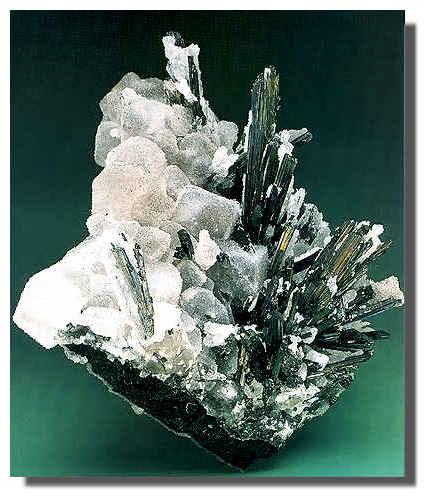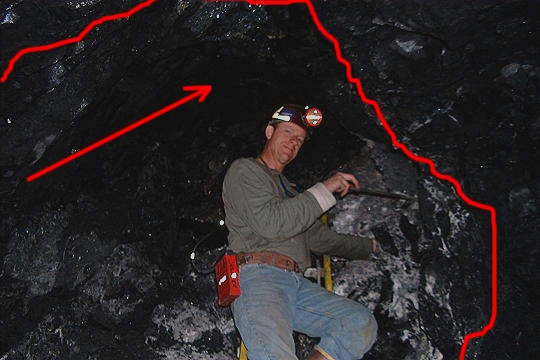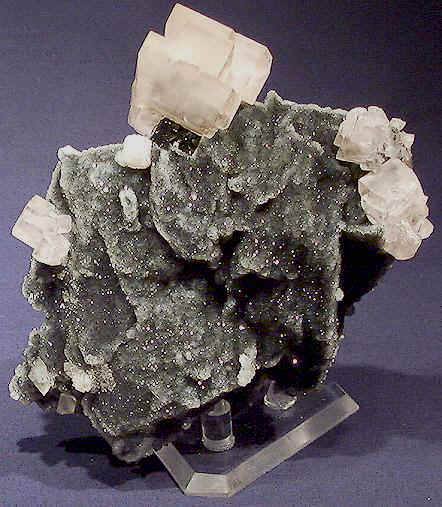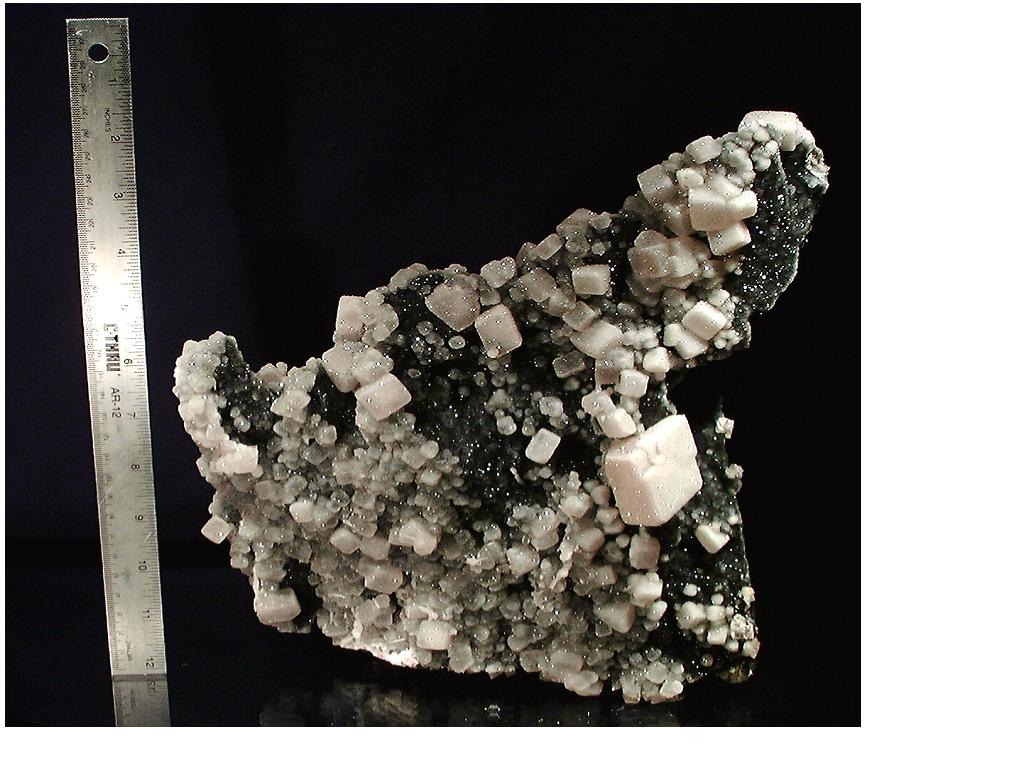
Yukon-Nevada Gold Corp
Jerritt Canyon
MURRAY MINE

Stibnite on Barite with Drusy Quartz
R. Griffis Collection
Jeff Scovill Photo
History
The
Murray mine is located in the Independence Mountains District and sits on a site
which was originally scouted for antimony ore.
Thirty to forty tons of stibnite as antimony ore were shipped from the
Burns Basin mine in the Independence Mountain Range between 1918 and 1945.
(Lawrence 1963; LaPointe et al.
1991). Antimony is used as a fire
retardant in such products as fire extinguishers and fire suits.
In the early 1970s there was a short burst in antimony exploration when
the ore reached a high of $40 per pound and a number of parties were scouting
northern Nevada, a known stibnite-producing area (pers. comm. Ralph Pray 1999).
By the late 1970’s the price had dropped to forty cents a pound.
Around 1971, FMC began exploring for antimony in the Burns Basic mine
area. Some of the rock FMC was
encountering was similar to the gold-hosting rock found at Newmont’s Carlin
mine, and technology had made recovery of the Carlin-type anomalous gold viable.
In the early to mid 1970s FMC discovered a disseminated gold deposit in
the Jerritt Canyon area and entered a joint partnership with Freeport
Exploration Company who became managers of the project.
Further exploration, drilling, sampling and mapping located three areas
bearing a low-grade gold ore – Marlboro Canyon, Alchem, and North Generator.
When mining began in 1981 they were collectively called the Enfield Bell
mine, or the Jerritt Canyon mine (LaPointe et al. 1991).
The joint partnership remained essentially the same, although Freeport
Exploration Company changed its name to Freeport McMoRan Gold Company and was
purchased by Minorco, which changed the name to Independence Mining Company; and
FMC’s gold division began using the name Meridian.
In early 1999, AngloGold acquired Independent Mining Company via
acquisition of Minorco and the AngloGold Jerritt Canyon Joint Venture is now a
70-30% partnership between AngloGold and Meridian operating the Murray, SSX and
MCE (Marlboro Canyon Extension) mines. After
the discovery of gold, mining stibnite for antimony held little interest for the
joint venture. However, the
stibnite holds interest for mineral collectors as some recent occurrences of
stibnite specimens from this location may prove to be the best found in North
America.
Geology
Murray and SSX are located in the structurally complex Independence Mountains about an hour’s drive north of Elko in the Independence Mountains District. Mineralization of the Murray and SSX mines in the Jerritt Canyon mining district is typical of Carlin-style sedimentary deposits, structurally controlled and hosted by intersections of faults and folds in favorable strata of the host rock. Ore in the Murray mine occurs in the Snow Canyon Formation (Ordovician), which covers the deposit, the Roberts Mountains Formation (Devonian to Silurian), and the Hanson Creek Formation (Silurian to Ordovician), which underlies the deposit. Ore has accumulated adjacent to and also in the intersecting New Deep fault system (NDF), which was one of the conduits for ore-forming fluids, and also in and near the Saval Discontinuity, the other major conduit that also separates the Roberts Mountains Formation from the Hanson Creek Formation. The Murray mine is located south of the original West and North Generator Hill Deposits, southwest of the Alchem and Marlboro Canyon deposits, and northwest of the original Burns Basic mine. Twelve miles south, the main orebody of the SSX mine occurs along the near-vertical South Boundary Fault, primarily in the Hanson Creek Formation and lesser amounts in the Roberts Mountain Formation. Specimens have so far been collected only from the Murray mine. (Kantor, Coli, and Eliason 1998). The SSX mine is on the location of the old Pattani Springs mine just north of the original Burns Basin mine.

Collecting
history.
Stibnite
crystals have apparently been collected from Jerritt Canyon mines for many
years, but, incredibly, few were saved from the crusher. The first mines were
open pit mines, and a stibnite of a foot to a foot and a half in length was
reportedly collected in the West Generator pit and used as a door stop for many
years (Joe Kantor 1999). In 1998 we
ran across some impressive specimens that compared respectably to Chinese and
Japanese stibnites, and which appeared to be superior to any stibnites from
North America we had seen, including those from the Manhattan mine in Nye County
(Jones 1999). Thus, while in
the area to work at the Meikle mine, we took advantage of an opportunity to
visit Independence Mining Company’s Murray mine.
In January 1999, we interpreted our first meeting with Greg Struble, mine operations manager, as a good omen. Struble personally escorted us underground on a Kubota mine tractor, which has become a familiar mode of transportation for us (although they use John Deere at Meikle). Struble took us to an area known as Z5-100 (zone 5 drift 100) which is located in the Roberts Mountain Formation. The heading had just been blasted on the previous shift and was now being mucked by a 5 cubic-yard loader. Between scoops of the mucker we would move in and inspect the broken ore while wetting down the muck pile with a hose. After about an hour of this, a pocket of clear, pseudocubic barite became visible on the right-hand rib of the drift. Our excitement grew as Struble informed us that this was a rare occurrence, as voids of this size were hardly ever encountered. Being there at the right time was most fortuitous. We were invited to stay on into the night shift to allow for ground support so we could then access this void under safe ground conditions. While waiting for the next shift, we toured the rest of the mine, and saw where the extraordinary stibnites with barite and drusy quartz we had seen earlier occurred. It seems likely that the stibnite occurred first in the void, then the barite, sometimes forming over the stibnite, and then the quartz. When the quartz formed over the stibnite, the apparently high-prevailing temperature destroyed the stibnite, leaving a quartz cast.
After exiting the mine through its main adit, we drove back to the mine operations building to wait for the night shift to come on before going back underground. We returned to the Z5-100 drift approximately 7 o’clock that evening. It took approximately two hours to finish bolting for ground support at which time we began our collecting efforts in the barite void. This pocket was approximately 1 meter wide and 1 meter high and .5 meter deep. The main characteristic of this pocket was that it had collapsed prior to being exposed by the blast; consequently, many of the barites were damaged. In addition, there was a thick iron coating on many of the specimens, making it difficult to see whether or not pieces had damage. One remarkable specimen that did survive is a matrix group with the largest crystal being about 10 cm across. (fig. ) The rocks at the Murray mine are all highly silicified or argillized. The prevalent matrix for both barites and stibnites appears to be a highly silicified carbonaceous limestone which has no reaction to hydrochloric acid. This first digging experience at the Murray was a very different experience than at the Meikle in that air temperatures hovered at about 65° F while just a couple a days earlier on the 1075 level at the Meikle temperatures tended to be closer to 110° F.
As of this writing, primarily small pockets (ranging from fist-sized to football-sized) of stibnite have been found, with most containing small needle crystals up to 2 inches in length, and many also containing stibiconite (double antimony oxide hydroxide). On one collecting trip in early April 1999, after a blast, some broken crystals and groups, and a couple of undamaged, extraordinary specimens were recovered off the muck pile, leading us to conclude that we were on the right track as far as fine stibnites go. Luckily several specimens did survive the harsh treatment and will be on display. Typical of the best we have seen , is the group of stibnite crystals with barite shown at the top of this page.
Collecting the Sugarbowl void as it was opened up

 Exceedingly
fine un-drused barite - 12x8cm ( Dave Bristol collection )
Exceedingly
fine un-drused barite - 12x8cm ( Dave Bristol collection )
Thus far, no large in-situ void of stibnite has been encountered, however we hope to have intersected the continuation of a pocket zone on a lower level. In March of 2000 mining ops revealed to us a large void that we subsequently named the "Sugarbowl Pocket". It was packed with psuedo-cubic barite crystals on jet black silicified limestone. Most of the barite, as well as the matrix of silicified limestone, is coated with a fine druse of micro-quartz crystals. The pocket of "sugar cube" barites was recovered over a period of several days. The pocket was several feet in dimension. Hundreds of beautiful specimens were saved. There was only a handful of stibnite specimens. This quartz/barite that now resides in the Huston Museum of Natural History.

Update as of winter 2010/11..........The Murray Mine has been closed for almost 5 years now.
Copyright © 2011 GEOPRIME MINERALS